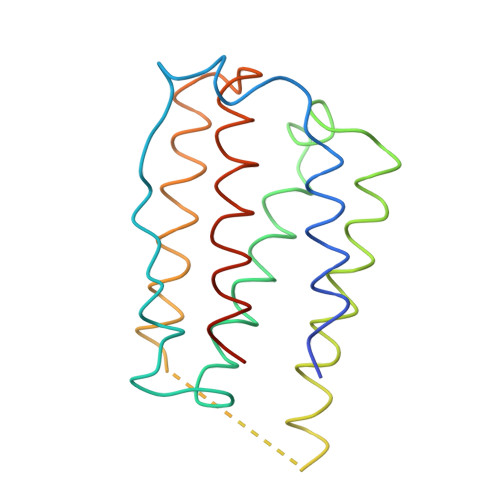Zinc mediated dimer of human interferon-alpha 2b revealed by X-ray crystallography.
Radhakrishnan, R., Walter, L.J., Hruza, A., Reichert, P., Trotta, P.P., Nagabhushan, T.L., Walter, M.R.(1996) Structure 4: 1453-1463
- PubMed: 8994971
- DOI: https://doi.org/10.1016/s0969-2126(96)00152-9
- Primary Citation of Related Structures:
1RH2 - PubMed Abstract:
The human alpha-interferon (huIFN-alpha) family displays broad spectrum antiviral, antiproliferative and immunomodulatory activities on a variety of cell types. The diverse biological activities of the IFN-alpha's are conveyed to cells through specific interactions with cell-surface receptors. Despite considerable effort, no crystal structure of a member of this family has yet been reported, because the quality of the protein crystals have been unsuitable for crystallographic studies. Until now, structural models of the IFN-alpha's have been based on the structure of murine IFN-beta (muIFN-beta). These models are likely to be inaccurate, as the amino acid sequence of muIFN-beta differs significantly from the IFN-alpha's at proposed receptor-binding sites. Structural information on a huIFN-alpha subtype would provide an improved basis for modeling the structures of the entire IFN-alpha family. The crystal structure of recombinant human interferon-alpha 2b (huIFN-alpha 2b) has been determined at 2.9 A resolution. HuIFN-alpha 2b exists in the crystal as a noncovalent dimer, which associates in a novel manner. Unlike other structurally characterized cytokines, extensive interactions in the dimer interface are mediated by a zinc ion (Zn2+). The overall fold of huIFN-alpha 2b is most similar to the structure of muIFN-beta. Unique to huIFN-alpha 2b is a 3(10) helix in the AB loop which is held to the core of the molecule by a disulfide bond. The structure of huIFN-alpha 2b provides an accurate model for analysis of the > 15 related type 1 interferon molecules. HuIFN-alpha 2b displays considerable structural similarity with muIFN-beta, interleukin-10 and interferon-gamma, which also bind related class 2 cytokine receptors. From these structural comparisons and numerous studies on the effects of mutations on biological activity, we have identified protein surfaces that appear to be important in receptor activation. This study also reveals the potential biological importance of the huIFN-alpha 2b dimer.
Organizational Affiliation:
Center for Macromolecular Crystallography, University of Alabama at Brimingham 35294, USA.















